
There’s always room for improvement with our teeth. The results of the last Adult Dental Health Survey revealed that just 77 per cent of adults brushed their teeth twice a day. Even then, the high level of plaque seen in this group suggests that brushing alone is not good enough. This is where water flossers come in.
Flossing the back of your mouth with string floss can be tricky if you have mobility issues. Cleaning between dental work for those with braces or fixed retainers can prove impossible. Thankfully, the electrical advantage of a water flosser is that pressurised water flushes out trapped food and debris from even the most hard-to-reach spots.
There are plenty of water flossers in 2025, but Waterpik’s WP-150 water flosser (£129.99, Boots.com) promises to remove up to 99.9 per cent of plaque from treated areas while being 50 per cent more effective at reducing gingivitis, a mild form of gum disease, compared to regular string floss.
Those are big claims, so I wanted to give Waterpik’s ultra plus a whirl to see how our teeth fared with this techy upgrade to the good old string floss. I got hands-on with the popular device to see how it compares to competitor models and regular flossing.
How I tested
With six different attachments to test, I used the flosser multiple times to gauge its effectiveness in each mode. Working my way around all of my teeth, I put the flosser through its paces at different times of the day to assess its effectiveness after sleeping and eating. While testing, I recorded the following information:
- Ease of use: With lots of items included in the box, from the water tank to the storage caddy, I recorded how simple it was to set-up the flosser, plus how easy it was to charge (does it need to be near a plug 100 per cent of the time?) and whether flossing itself took some getting to grips with.
- Design: Bathrooms aren’t often the most spacious rooms in a home, so I weighed up how practical the design was for an average home. I wanted to see if it was easy to store, and I also judged the quality and ergonomics of the attachments, storage holders, flosser grip and setting switches.
- Results: After eating and drinking (including coffee and wine), I recorded how well the flosser’s various attachments tackled our daily and weekly plaque build-up, and noted any mishaps or instances of sensitivity.
Why you can trust IndyBest reviews
IndyBest is The Independent’s shopping section, where experts examine a wide range of products for unbiased reviews. Qin Xie has tested several products for IndyBest, from pillow protectors and scalp massagers to the BlueAir dustmagnet 5240i air purifier.
Is the Philips sonicare 9900 prestige the ultimate travel companion?
Spotlight Oral Care sonic electric toothbrush review: Our verdict for stain removal
12 best electric toothbrushes, tried and tested for a professional clean
I’ve switched to a plant-based electric toothbrush and will never look back
12 best teeth whitening kits: Strips, gels, powders and pens, tried and tested
Waterpik ultra plus WP-150 water flosser

Reservoir capacity: 651ml, or up to approx. 90 seconds of use
Number of water pressure settings: 10 (10 to 100PSI)
Power: Mains via shaver socket
Tip attachments: Classic jet (nozzle), tongue cleaner, orthodontic, pik pocket (for periodontal pockets), plaque seeker and toothbrush
Why we love it
- Mains power means no depleted charge mid-use
- A much better flosser than physical dental floss
- Cater to multiple oral requirements
Take note
- Toothbrush tip doesn't fit into flosser seamlessly
- Not a huge upgrade on WP-120 model
- Takes a bit of getting used to
The Waterpik ultra plus WP-150 water flosser has three main parts: the base, the reservoir and the wand. On the sturdy white plastic base, you’ll find the main on/off button for the device as well as the pressure dial. The electricity cord flows out of the back and plugs into a shaver socket. In the front, there’s also a holder where you can rest the wand when it’s not in use.
The removable clear plastic reservoir sits on top of the base. On one side of its base is a valve that stops water from dripping out after you fill it; the valve is also where the machine draws the water from the reservoir to pump into the wand. Covering the top is a matching white plastic lid that doubles as a storage caddy for the interchangeable tips.
Six standard tips come with the machine – classic jet (nozzle), tongue cleaner, orthodontic, pik pocket (for periodontal pockets), plaque seeker and toothbrush – each designed for a different function.
The handle is attached to the base via a coiled tube. At the very top is a rotating dock capable of turning 360 degrees. The tips slot in here with a click, and just below it is the eject button you use to remove them. Further down, there’s an on/off slider to start or stop the water during use.
Features
The ultra plus WP-150 is one of Waterpik’s highest spec countertop devices. It features 10 pressure modes, ranging from 10PSI to 100PSI, and comes with six interchangeable tips with different functions. Realistically, you’ll rely on one or two in everyday use.
For general cleaning, my favourite is the classic jet, a nozzle that simply shoots out a jet of water to clean between the teeth and below the gumline. You also get the toothbrush tip, like those found on standard electric toothbrushes, so you can brush your teeth and floss at the same time. There’s also a tongue cleaner, which is a bowled scraper that can shoot out a jet of water at the same time to help improve general oral hygiene and reduce halitosis (bad breath).
Those with problem teeth may find the pik pocket helpful. It’s tapered to a very fine point, producing a more targeted and higher pressure stream of water for cleaning periodontal pockets (openings around the teeth) and furcations (where the roots of the teeth show).
There are also two tips for those with special dental work. The orthodontic tip has a fairly dense brush, with the bristles concentrated in the middle, which is designed to get into the nooks and crannies in braces. The plaque seeker has bristles split into three pockets on the edge of the tip and is designed for implants, crowns, bridges and retainers.
Read more: 9 best environmentally-friendly razors for a clean shave
Compared to the slightly cheaper ultra WP-100 (£100.52, Amazon.co.uk), there isn’t a huge amount of difference, save for the chrome accent and the built-in storage in the lid of the ultra plus WP-150. The next level up is the ultra-professional WP-660 (was £99, now £84, AO.com), which has an LED display, seven tips included and an additional massage mode.
Usage
Getting started with the ultra plus WP-150 is easy, even for novice water flossers.
You start by filling the reservoir with warm water – cold water will be very uncomfortable, especially for those with sensitive teeth. When replacing the reservoir, push it firmly into the base to make sure the valve slots into place; the machine will still work when it isn’t lined up properly, but the water pressure will be extremely weak. After drying off any spills and your hands, you can plug the machine into the shaver socket for use.
The machine turns on at the base, where you can also adjust the pressure, but the water won’t start flowing until you toggle the second switch on the wand. Waterpik recommends starting from one and working your way up to a pressure that suits you. I found that three is a good pressure for the classic jet tip but you’ll need to go up to four or five if you’re using the plaque seeker or orthodontic tip, and bring the pressure right down to one for the pik pocket.
Read more: 8 best kids’ toothbrushes they’ll actually want to use
With the chosen tip placed perpendicular against your gum line, and your lips slightly open, you lean over the sink and toggle the switch on the wand to release the water. Then it’s just a case of moving the tip along the gum line, pausing for a second or two at the gaps between your teeth, and allowing the water to rinse out any debris or trapped food.
Because the wand is attached to the machine via the coiled tube that feeds it water, it can be a bit awkward to use at first. I found that it would sometimes catch during use, but once I got into the swing of things, I quickly learned to adjust our movements to achieve the best cleaning results. The first time I used it, I was surprised by the amount of debris it washed out, and I was impressed by the fact that there was nothing left for my regular dental floss to pick up.
Buy now £129.99, Boots.com
The verdict: Waterpik ultra plus WP-150 water flosser
Compared to regular dental floss, the Waterpik ultra plus WP-150 water flosser was much easier and much faster to use. As it uses mains electricity, there was no need to wait for it to charge, but it requires an American bathroom setup: the shaver socket needs to be near the sink, and there must be a flat surface for you to set the device on.
I loved the fact that it has so many pressure settings, and you can swap out the tips, meaning the whole family can use just one device. For everyday cleaning, the classic jet is more than sufficient, and I found great results. Those with special dental work might also benefit from one of the specialist tips, but I recommend gently sweeping it across your teeth rather than pressing it right against them, as otherwise the bristles can get caught. My only gripe was the toothbrush tip, which I felt didn’t sit in the wand firmly enough for everyday use.
For more toothy reads, browse our review of the 14 best whitening toothpastes for brighter teeth and fresher breath







